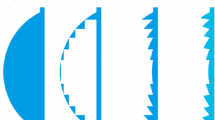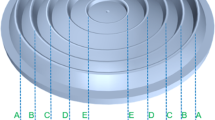Abstract
Although the layout of multicavity molds is a geometrically balanced design, when the melt flows into the runner, the shear-induced partial changes in material properties will result in intracavity imbalance. This study placed a rectangular flow restrictor within the tertiary runner of a precision optical lens mold to create melt turbulence through flow blocking. Due to polymer rheological characteristics, uniform melt temperature distribution in the runner channel could be obtained, making the temperature distribution inside the cavity more uniform, and reducing the thermal residual stress and warpage of injection molded parts. The optimal runner restrictor design is placing 5 mm away from the secondary runner centerline, making both the depth and the width of the block 3 mm. A relatively uniform melt temperature distribution with a maximum temperature difference of 1.1 °C can be achieved. Injection molds were fabricated according to the optimized restrictor design, and experimental verification was performed. The contour accuracy of a lens parallel to injection direction was improved from 10.44 to 5.03 μm. Therefore, this runner restrictor design can be applied to high-precision optical molds due to the ease of machining and the capability of improving the quality of optical lens.
Similar content being viewed by others
References
Wang PJ, Lai HE (2007) Study of residual birefringence in injection molded lenses. SPE ANTEC Conf 2498
Chen SC, Wang IC, Chiou YC, Chou YY, Yang WH (2007) An investigation on the temperature behavior in mold embedded with heater. SPE ANTEC Conf 722
Chen X, Lam YC, Li DQ (2000) Analysis of thermal residual stress in plastic injection molding. J Mater Process Technol 101:275–280
Young WB (2005) Effect of process parameters on injection compression molding of pickup lens. Appl Math Model 29:955–971
Park K (2004) A study on flow simulation and deformation analysis for injection-molded plastic parts using three-dimensional solid element. Polymer Plast Tech Eng 43:1569–1585
Lu X, Khim LS (2001) A statistical experimental study of the injection molding of optical lens. J Mater Process Technol 113:189–195
Cao W, Shen C (2005) Two solutions for three-dimensional flow simulation of injection molding. SPE ANTEC Conf 486–490
Seow LW, Lam YC (1997) Optimizing flow in plastic injection molding. J Mater Process Technol 72:333–341
Huang MC, Tai CC (2001) The effective factors in the warpage problem of an injection-molded part with a thin shell feature. J Mater Process Technol 110:1–9
Choi DS, Im YT (1999) Prediction of shrinkage and warpage in consideration of residual stress in integrated simulation of injection molding. Compos Struct 47:655–665
Zhou H, Li D (2005) Residual stress analysis of the post-filling stage in injection moulding. Int J Adv Manuf Technol 25:700–704
Li CT, Wu BY, Chen TS (2006) Modeling study of the surface tension and gravitational effects on flow injection in center-gated disks. Int J Adv Manuf Technol 28:1104–1110
Wu CH, Huang YJ (2007) The influence of cavity deformation on the shrinkage and warpage of an injection-molded part. Int J Adv Manuf Technol 32:1144–1154
Koo BH, Choi KI (2005) Three-dimensional mold cooling analysis for injection molding process. SPE ANTEC Conf 521–525
Kim SW, Turng LS (2006) Three-dimensional numerical simulation of injection molding filling of optical lens and multiscale geometry using finite element method. Polym Eng Sci 46:1263–1274
Kang SY, Kim SM, Lee WII (2007) Finite element analysis for wavelike flow marks in injection molding. Polym Eng Sci 47:922–933
Chang RY, Chang YR, Peng YH, Yang WH, Hsu CH (2007) True 3D simulation of flow-induced residual stress in injection molding. SPE ANTEC Conf 2452–2455
Sun YF, Lee KS, Nee AYC (2004) Design and FEM analysis of the milled groove insert method for cooling of plastic injection moulds. Int J Adv Manuf Technol 24:715–726
Mathivanan D, Parthasarathy NS (2009) Prediction of sink depths using nonlinear modeling of injection molding variables. Int J Adv Manuf Technol 43:654–663
Chiang YC, Cheng HC, Huang CF, Lee JL, Lin Y, Shen YK (2011) Warpage phenomenon of thin-wall injection molding. Int J Adv Manuf Technol 55:517–526
Gao YH, Wang XC (2008) An effective warpage optimization method in injection molding based on the Kriging model. Int J Adv Manuf Technol 37:953–960
Li C, Wang FL, Chang YQ, Liu Y (2010) A modified global optimization method based on surrogate model and its application in packing profile optimization of injection molding process. Int J Adv Manuf Technol 48:505–511
Zhao P, Zhou HM, Li Y, Li DQ (2010) Process parameters optimization of injection molding using a fast strip analysis as a surrogate. Int J Adv Manuf Technol 49:949–959
Chang TC (2001) Shrinkage behavior and optimization of injection molded parts studied by the Taguchi method. Polym Eng Sci 41:703–710
Min BH (2003) A study on quality monitoring of injection-molded parts. J Mater Process Technol 136:1–6
Postawa P, Koszkul J (2005) Change in injection moulded parts shrinkage and weight as a function of processing conditions. J Mater Process Technol 162–163:109–115
Ozcelik B, Erzurumlu T (2006) Minimization of warpage and sink index in injection-molded thermoplastic parts using Taguchi optimization method. Mater Des 27:853–861
Tang SH, Tan YJ, Sapuan SM, Sulaiman S, Ismail N, Samin R (2007) The use of Taguchi method in design of plastic injection mould for reducing warpage. J Mater Process Technol 182:418–426
Li HS, Guo ZY, Li DQ (2007) Reducing the effects of weldlines on appearance of plastic products by Taguchi experimental method. Int J Adv Manuf Technol 32:927–931
Kurt M, Kaynak Y, Kamber OS, Mutlu B, Bakir B, Koklu U (2010) Influence of molding conditions on the shrinkage and roundness of injection molded parts. Int J Adv Manuf Technol 46:571–578
Chiang KT, Chang FP (2007) Analysis of shrinkage and warpage in an injection-molded part with a thin shell feature using the response surface methodology. Int J Adv Manuf Technol 35:468–479
Lo WC, Tsai KM, Hsieh CY (2009) Six Sigma approach to improve surface precision of optical lenses in the injection-molding process. Int J Adv Manuf Technol 41:885–896
Beaumont JP, Young JH, Jaworski MJ (1998) Mold filling imbalances in geometrically balanced runner systems. SPE ANTEC Conf 599–604
Beaumont JP (2004) Runner and gating design handbook. Hanser, Cincinnati
Alam K, Kamal MR (2005) A robust optimization of injection molding runner balancing. Comput Chem Eng 29:1934–1944
Takarada KR, Coulter JP, Myers M, Beaumont JP (2006) The effect of primary runner length on fill-imbalance in a geometrically balanced eight cavity polymer injection mold. SPE ANTEC Conf 1098–1102
Rhee BO, Park HP, Cha BS, Lee K (2006) An experimental study of the variable-runner system. SPE ANTEC Conf 1113–1117
Ryim WG, Yun SM (2007) Determination of gate locations in computer-aided injection molding analysis. SPE ANTEC Conf 649–652
Baesso R, Lucchetta G (2007) Filling balance optimization by best gate location. SPE ANTEC Conf 662–666
Lam YC, Britton GA, Liu DS (2004) Optimization of gate location with design constraints. Int J Adv Manuf Technol 24:560–566
Zhai M, Xie Y (2010) A study of gate location optimization of plastic injection molding using sequential linear programming. Int J Adv Manuf Technol 49:97–103
Chiou YC, Chou YY, Chiu HS, Yu CK, Hsu CH (2007) Integrated true 3D simulation of rapid heat cycle molding process. SPE ANTEC Conf 2577–2580
Author information
Authors and Affiliations
Corresponding author
Rights and permissions
About this article
Cite this article
Tsai, KM. Runner design to improve quality of plastic optical lens. Int J Adv Manuf Technol 66, 523–536 (2013). https://doi.org/10.1007/s00170-012-4346-2
Received:
Accepted:
Published:
Issue Date:
DOI: https://doi.org/10.1007/s00170-012-4346-2




